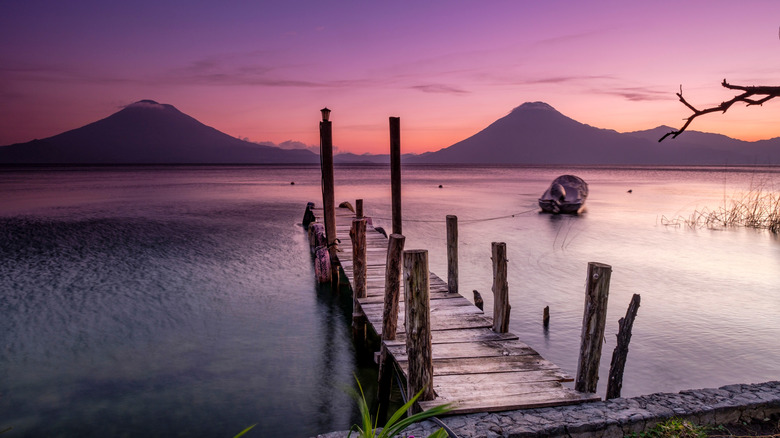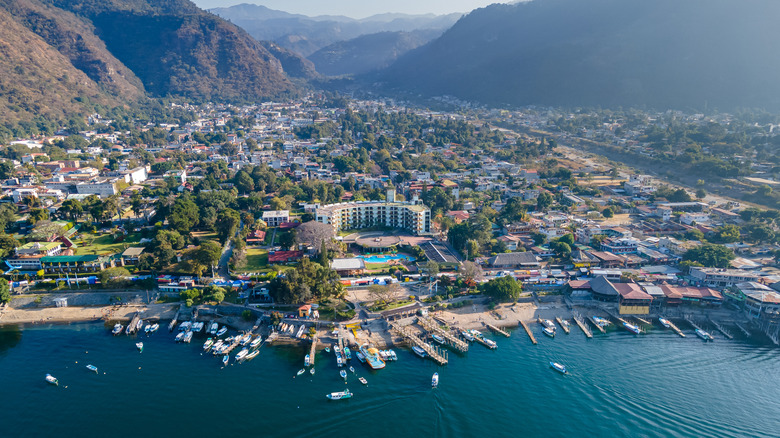How Tourists Can Explore The Mystical, Atlantis-Like Ruins In Guatemala's Lake Atitlán
Lake Atitlán, located in the Guatemalan highlands, has quickly become a popular budget-friendly vacation spot for adventurous travelers — but it's been inhabited by indigenous Mayan people for generations. Tourists adore swimming in the sparkling water, hiking to the tops of massive volcanoes, and indulging in various wellness-related activities.
Lake Atitlán has been dubbed the "Land of Eternal Spring" due to its pleasant climate. The stunning Central American destination is surrounded by picturesque villages and is the deepest and highest altitude lake in Central America. Three massive volcanoes tower above the lake: Atitlán, San Pedro, and Tolimán. Many travelers list Lake Atitlán among the most beautiful lakes in the world, and it has become a haven for backpackers and spiritual tourists. Many believe that the lake is an energy vortex and that it can have a profound spiritual, physical, and emotional impact on visitors. For this reason, many travelers flock to this sacred Mayan destination from around the world in search of inspiration, healing, and natural beauty.
Visitors who are interested in ancient history will love learning about Samabaj, a Mayan spiritual site that disappeared beneath the water's surface nearly two thousand years ago due to a volcanic eruption. The ruins offer a fascinating glimpse into the region's rich history and the spiritual practices of the Ancient Mayans. Tourists can learn more about the history of the forgotten Mayan city, which has been compared to the lost city of Atlantis, at the Museo Lacustre.
The discovery of Samabaj in Lake Atitlan
In 1998, a Guatemalan man named Roberto Samayoa was scuba diving in Lake Atitlán. It wasn't the first time he had explored the lake's crystal clear waters, but on that day he made a fascinating archaeological discovery. He noticed what appeared to be the ruins of a great city beneath the water's surface and quickly reached out to archeologists to tell them about his miraculous find. His discovery was met with scrutiny until he shared photos of what appeared to be stone staircases and a town square.
When archaeologists arrived on the scene they quickly realized the significance of Samayoa's discovery. Time has taken its toll on many of our world's ancient ruins. Looters and grave robbers have stolen valuable objects, vandalism has destroyed structures that could have provided a glimpse into past civilizations, and colonizers destroyed countless sacred sites in an attempt to assert dominance over indigenous people — but the lost Mayan ruins under Lake Atitlan have remained untouched for hundreds of years.
Over the next several years archaeologists worked to understand the ruins and came to the conclusion that the city was once considered a deeply sacred place. Ancient Mayans from all over the region would visit the site as a religious pilgrimage. When they arrived they would cleanse themselves physically and spiritually in sweat lodges — similar to the temazcal saunas that are still used today. There were also several temples and places to make sacrificial offerings to the gods. In total, there were 16 different sacred structures discovered beneath the lake.
Learning more about the Samabaj ruins
The ruins of Samabaj are believed to be over 1,700 years old. Experts estimate that the city began to sink between 250 and 300 CE when the massive Atitlán volcano erupted and the lava dammed up the lake. As the rains continued, the water level slowly rose, eventually sinking the small island where the city of Samabaj was built. It may have taken up to a year for the city to become fully submerged, which would have allowed residents plenty of time to escape.
Although there are scuba diving tours offered around the thrilling, adventure destination of Lake Atitlán, the ruins themselves are currently closed to scuba diving tourists in order to preserve the historical site. Research is ongoing, and much of the ruins remain unexplored since it's challenging to perform archaeological projects underwater. The best way to explore the fascinating history of Samabaj is by visiting Museo Lacustre, also known as the Museum of Underwater Maya Archaeology. The museum is located in the town of Panajachel, which is often referred to as "Pana" by locals. You'll find the museum at Hotel Posada de Don Rodrigo. Inside, you can see ancient artifacts discovered around the lake, learn about Mayan history, and explore an exhibit dedicated to the discovery of Samabaj. To get a better feel for what the underwater ruins look like, tourists can visit the Iximche ruins, located about 1.5 hours from Panajachel by car. To get there, you will need to hire a taxi in town and arrange for return transportation.


